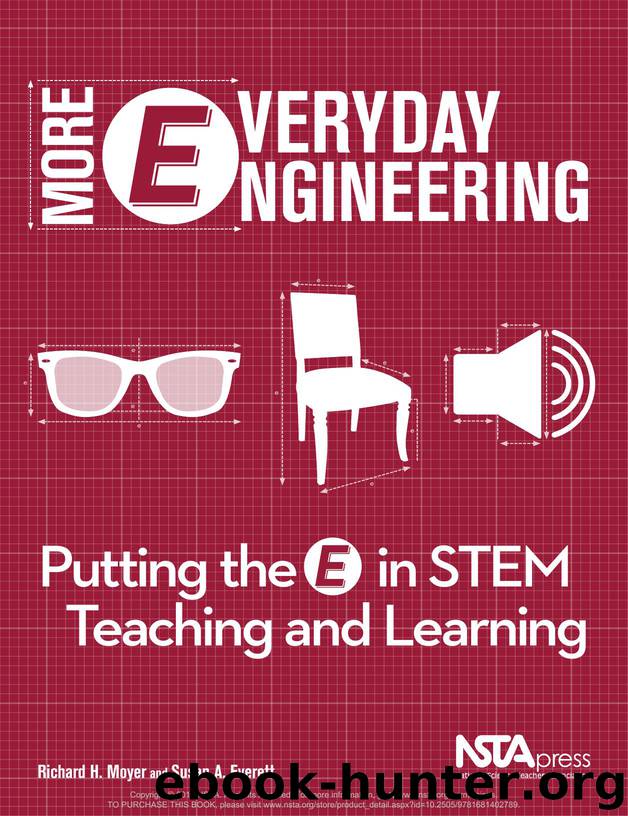More Everyday Engineering: Putting the E in STEM Teaching and Learning by Unknown

Author:Unknown
Language: tur
Format: azw3
Published: 2016-06-23T21:28:53+00:00
58
CHAPTER
copper compounds, depending on the composition
Experimental results
of the atmosphere.
for coatings in a moist
environment: (A) Petroleum
Explore
FIGURE 8.3 jelly, (B) Household oil,
(C) Lip balm, (D) Correction
Ask students what may be done to prevent copper from
fluid, (E) Cooking spray, and
corroding. Students may initially suggest putting the
(F) Control
pennies in a jar or another hermetically sealed container
to prevent contact with the atmosphere. Other sugges-
tions may include covering the pennies with plastic wrap
or bags. The Explore question helps direct student focus
to the use of coatings to protect the pennies.
This investigation will require two days. Although
some corrosion will be observable in the acidic envi-
ronment in about an hour, it is much easier to see
after waiting overnight. Thus, plan on storing the
petri dishes where they will not be disturbed for a day.
Depending on the experience level of your students,
you may wish to have them design their own experi-
mental procedures. We have provided one example
for students to follow (see Activity Worksheet 8.1,
pp. 62–63). This may be a good time to review the key
components of an experiment, such as identifying the
independent and dependent variables and quantitative
versus qualitative data. In the experiment described
here, there are two independent variables: the type position. In this case, there is an obvious change in of atmospheric environment and the type of coating. color from the shiny copper to the shades of brown The dependent variable is the change in the color and and the green patina. Students will note that some of sheen of the coins. Students will be making qualitative the coated pennies did not experience the chemical observations.
change of corrosion.
Some students may observe that painting a penny
Explain
represents a color change and may therefore incorrectly
The results will depend on the coatings used, but infer that this is evidence of a chemical change. Help students will likely find that the acidic environment these students understand that painting the coin is produces more corrosion on the pennies than the non-actually a physical change and to think of the paint as
acidic one. Typical results for the coated pennies in the a physical barrier. One might try using an analogy of moist environment are shown in Figure 8.3 and in the a more visible physical barrier, such as wrapping the moist, acidic environment in Figure 8.4.
coin in plastic wrap to prevent the corrosive reaction.
Discuss with students what constitutes evidence
To help students reach an overall conclusion
that a chemical reaction has taken place. Common regarding the effectiveness of the various coatings, evidence includes color change, temperature change, discuss all findings with the entire class. Ask students the formation of a gas or a precipitate, odor, or decom-to analyze each of their coatings to assess benefits and
National Science Teachers Association
Copyright © 2016 NSTA. All rights reserved. For more information, go to www.nsta.org/permissions.
TO PURCHASE THIS BOOK, please visit www.nsta.org/store/product_detail.aspx?id=10.2505/9781681402789.
Download
This site does not store any files on its server. We only index and link to content provided by other sites. Please contact the content providers to delete copyright contents if any and email us, we'll remove relevant links or contents immediately.
| Automotive | Engineering |
| Transportation |
Whiskies Galore by Ian Buxton(41708)
Introduction to Aircraft Design (Cambridge Aerospace Series) by John P. Fielding(33011)
Small Unmanned Fixed-wing Aircraft Design by Andrew J. Keane Andras Sobester James P. Scanlan & András Sóbester & James P. Scanlan(32678)
Craft Beer for the Homebrewer by Michael Agnew(18072)
Turbulence by E. J. Noyes(7886)
The Complete Stick Figure Physics Tutorials by Allen Sarah(7257)
Kaplan MCAT General Chemistry Review by Kaplan(6811)
The Thirst by Nesbo Jo(6747)
Bad Blood by John Carreyrou(6467)
Modelling of Convective Heat and Mass Transfer in Rotating Flows by Igor V. Shevchuk(6348)
Learning SQL by Alan Beaulieu(6151)
Weapons of Math Destruction by Cathy O'Neil(6073)
Man-made Catastrophes and Risk Information Concealment by Dmitry Chernov & Didier Sornette(5864)
Digital Minimalism by Cal Newport;(5575)
Life 3.0: Being Human in the Age of Artificial Intelligence by Tegmark Max(5394)
iGen by Jean M. Twenge(5292)
Secrets of Antigravity Propulsion: Tesla, UFOs, and Classified Aerospace Technology by Ph.D. Paul A. Laviolette(5231)
Design of Trajectory Optimization Approach for Space Maneuver Vehicle Skip Entry Problems by Runqi Chai & Al Savvaris & Antonios Tsourdos & Senchun Chai(4949)
Electronic Devices & Circuits by Jacob Millman & Christos C. Halkias(4859)
